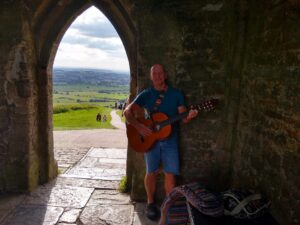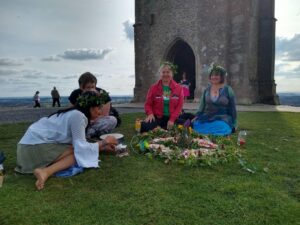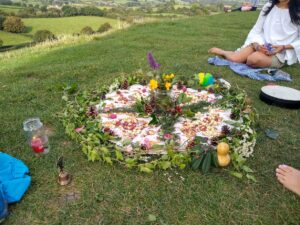On Glastonbury Tor
September 27, 2021 Blog
There are always interesting characters to be found on Glastonbury Tor and my latest visit was no exception.
I was having a few days of retreat at Downside Abbey, the Benedictine monastery in Somerset not far from Glastonbury. On my previous stay at Downside I'd also climbed the Tor, on which occasion there was a large group of women performing some kind of ritual which included a circle dance and various incantations, as well as them laughing a lot and breaking out into the singing of old pop songs in the tower. There had been a nice energy about the group and I'd wished I could be part of it.
On this occasion I'd seized the opportunity of a sunny day on which to drive over and make the steep ascent. The Tor stands at about 180m and commands spectacular views in every direction, even, on such a clear day, all the way across the Bristol Channel to a point on the Welsh coast forty-five miles away. St Michael's Tower is perched right on the top and I especially love to look through the archways on each side. They provide a pleasant framing of the view beyond. It has been a site of pilgrimage for centuries and the following day, it was explained to me later, it would be especially busy because of the Autumn equinox. The site is said to be on a certain 'ley line', believed to be routes of particular sacred energy going in a straight line across the country and linking particular holy places.
On my previous visit to the Tor I'd been reminded of a place on the Camino to Santiago with similarly vast and commanding views from a high point over the surrounding flat countryside and a sense that it was somewhere the ancient Celts might have described as being a 'thin place' i.e. there being a thin veil between earth and heaven. This time I was mainly relishing the uncommonly warm day and, like many of those who had made the climb, lying down in the sun. I was also, as I like to do, observing those around me! Of particular interest was a woman who appeared through the archway of the tower with an ivy chain around her head. She was closely followed by a second and then a third woman who were each of them similarly adorned, also carrying armfuls of ivy and other bits and pieces. 'What's going on here, then?' I wondered. They proceeded to set up shop on the grass, creating a circle of ivy and other things and with a vase of flowers at the centre. And one of them was lighting some kind of incense. One or two similarly curious onlookers asked what they were doing and one of the three explained that they were performing a little ceremony for Mother Earth and getting rid of bad things from their lives and welcoming the new. A woman who until then had been sunbathing asked to join them and she was welcomed and crowned with an ivy chain. And then the ritual began, which included the ringing of a bell, the beating of a drum and one of the women moving round the circle spreading the sweet-melling incense. It was a little bit wacky but I suppose to many people these days the liturgies I'd been attending in the Abbey church might seem equally wacky. At any rate, seeing a ritual performed by women was a nice counterpoint to the exclusive maleness of that morning's monastic Mass. I reflected as well that some of what the women were doing wasn't too far from what the monks had been doing on the Sunday in their High Mass, at least in terms of the incense, with a deacon having gone round the altar with the thurible; except that the men didn't have a bunch of pretty flowers in the middle!
It was then that I heard a guitar and singing coming from inside the tower and went to explore. A man was there and he had a lovely, gentle voice which was pleasantly amplified by the acoustics of the tower, and when he finished I clapped in appreciation, along with a couple who were listening as well. He was explaining to the couple in answer to them asking where he came from that he lived in Spain, although I could hear the unmistakable sound of a Dublin accent. After the couple made their leave I got chatting with him and he was interested to hear about my background and about the work of the Irish Chaplaincy. I asked him his name. He replied that he'd been born Denis (and a Roman Catholic) but had changed his name twenty years ago to Ananda. When I later checked the spelling with him he said, "It's like Amanda but you just change the 'm' to an 'n'!" He told me that the word in Hinduism, as in Buddhism and Jainism, denotes extreme happiness and is one of the highest states of being. He believed in the unity in all religions and as if to demonstrate that he sang to me a self-composed mantra which began, conventionally enough, with the words that had been sung that morning in the monastic Mass, 'Kyrie eleison', Lord have mercy. Ananda's version continued, 'Maria eleison, Mama eleison, Allah eleison, Buddha eleison' before ending with another verse of 'Kyrie eleison'.
He went on to tell me that he'd lived in Glastonbury for four year and had walked up the Tor every single day, rain or shine, with his guitar and it was his personal ministry to sing in the tower and chat to people. He also pointed out to me the Celtic connections with the area. An old legend has it that Patrick came back to Britain as an old man and gathered together some hermits in Glastonbury and became the first Abbot. What's more, the carved figure of Brigid, patron saint of the Irish Chaplaincy as I explained to Ananda, is carved right there in St Michael's Tower where we were speaking. Legend has it that she spent two years in Glastonbury in prayer before founding in Kildare her dual monastery, one for women and one for and men and over both of which she ruled as abbess.
Ananda was summoned to go and meet his wife, his ring tone being a nice bit of violin music! As he invited me to "go well" I decided it was time to be brave and engage with the ivy-clad women. I went over and asked if I could take a photo of their circle and one of them said with a smile, "Do you want the models in the picture?" I asked what the incense had been and was told it had been sage and myrrh. "Oh" I said, "sage was used by the native Americans to purify the atmosphere of bad vibes." I happened to know that because when I'd been in a role at L'Arche that seemed to involve having a lot of tricky 1 to 1 meetings, my counterpart in L'Arche London, an American called Keith, used to tell me about the sprig of sage he kept hanging in his office for such meetings. We'd call one another sometimes and say, "So how much sage did you need to burn today?"
Later I went for a stroll in the town which is a truly fascinating place. On the residential street leading to the centre almost every other house has a statue of the Buddha in the window. Then there is the main street, which is a veritable hot-potch of what used to be called 'New age mysticism': tarot card reading, crystals, hypnotherapy, 'Saturday morning yoga with Andrew', the 'Zen Music Shop'. Outside the C of E parish church a wizard had set up a stall, next to a man playing reggae music, and was waving cheerfully to passers-by. Ananda had told me that Glastonbury is home to seventy-three different religions and beliefs, the highest such concentration anywhere on the planet. There was even an RC church. How, I wondered, did they get on in the midst of the seventy-three?
I was kind of relieved to get back to the peace, and monotheism, of the monastery. Interestingly, the book being read that evening in the monastic refectory was by a Benedictine who made the observation that the professed religious life as we know it in the West is in terminal decline. The Downside community is typical in that most of the eight members are in their seventies or older and they are currently planning to leave their home of the last 150 years and move in with another, similarly diminishing, community. I agree with the prognosis of terminal decline and think we, the ever dwindling faithful in the Church need to be honest about that rather than hold our heads in the sand. I think there might not be more than a couple of decades left, in the West at any rate, of a tradition that goes back over 1600 years and which has had such a profoundly positive impact on civilisation, in such areas as healthcare and education, even in the development of champagne, thanks to Dom Pérignon, a French Benedictine monk.
What will take its place? The innate human yearning for meaning will still be there, and a need for ritual. Many of us will continue to seek places of stillness; and a sense of the sacred will be as strong as ever, however that finds its expression. My guess is that things could get even more eclectic and a whole lot more wacky! But I take comfort in the words of one of the spiritual greats (I'm afraid I can't remember which one): "The good will out."





